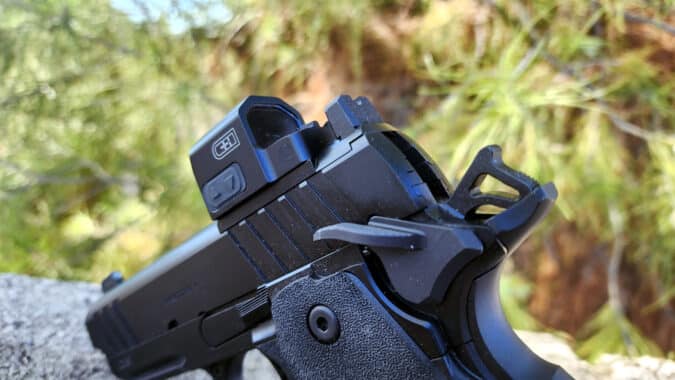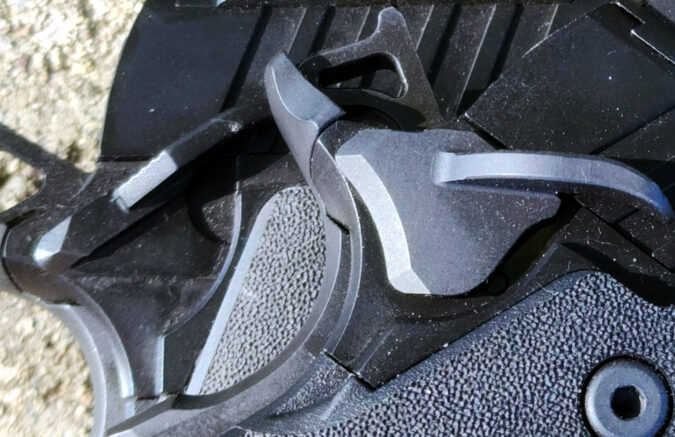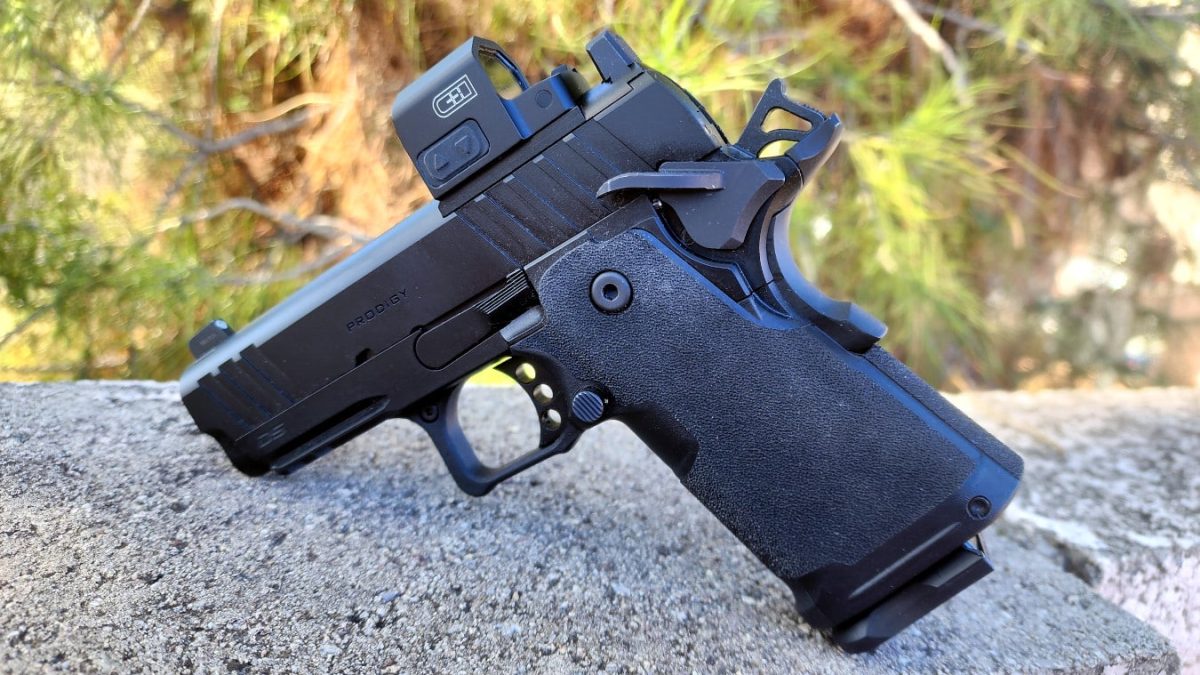With a new year and SHOT just around the corner, Springfield Armory is kicking things off with a new version of their extremely popular Prodigy double-stack 1911! With the same DNA of the rest of the line, the Prodigy Compact scales things down to make a more attractive package for CCW.
SPECS
- Caliber: 9mm
- Color: Black
- Barrel: 3.5″ or 4.25” Forged Stainless Steel, Black DLC, Match Grade, Bull, 1:16
- Slide: Forged Carbon Steel, Black Cerakote®, Optics-Ready
- Frame: Billet 7075-T6 Hardcoat Anodized Aluminum, Black Cerakote®
- Sights: Tritium Front, Black Serrated Rear
- Recoil System: Captured Guide Rod
- Grips: Polymer
- Magazines: (2) 15-Round (flush fitting)
- Weight: 25.5 oz (3.5”) | 29 oz (4.25”)
- Length: 7″ | 7.8”
- Height: 5.1″
- MSRP: $1,549
TRIGGER TIME
Small pistols are like small dogs, snappy and annoying. I’m not a Chihuahua guy, my dogs are all pit bull mutts, herding dogs, or hounds. With the new Prodigy Compact, based on looks alone, my expectations were tilting towards the Chihuahua side of the scale. Turns out, this little dog has some Great Dane in it.
The Prodigy Compact looks smaller than it really is. A full-size Prodigy lets me get all my fingers on the grip with about another 3/4 finger width left over. The Compact grip gives me exactly the room I need for all my fingers. In comparison, a standard Glock 19 grip leaves me about a 1/8th of a finger short on the grip without a mag well or something to give me that tiny extra room.
Being able to get a complete grip makes a big difference. Even with a 3.5-inch barrel, a length that is often pretty snappy, the Prodigy Compact shoots smoothly and with a hair more snap than the standard full-size Prodigy. You can feel the slide returning into battery faster, but the recoil in your hand is nearly the same.
Side-by-side running drills with my EDC CCW pistol that has a comp, the times were fractionally different and almost certainly due to familiarity rather than design. The Prodigy Compact performed extremely well in nearly every respect.
The Compact retains almost everything found on the full-size version. The grip is very grippy with an almost high-grit sandpaper feel, but it doesn’t rub your skin raw either in shooting or in carrying. Slide serrations are deep and on both the front and rear, and the AOC optic system is probably one of, if not the best on the market. While Springfield didn’t design it, I love that it partnered with Agency Arms to bring it to us.

What really stands out about the Prodigy Compact is how much shooting it feels nearly identical to shooting the full-size Prodigys. Springfield didn’t just chop the grip and the barrel and call it good. Instead, it clearly took the extra time to make sure the grip was the perfect size to still deliver a full-sized feeling, and the spring weight was optimized for the shorter barrel and lighter slide.
For me, the full-size Prodigy has less muzzle rise, doubly so with the Prodigy Comp. Still, the Compact didn’t feel snappy and that’s a big deal. Shooting the Compact in long training sessions or on the clock at a match didn’t beat up my hands.
In the best way possible, the Prodigy Compact is a smaller Prodigy.
Safety First
One other difference between the bigger Prodigy models and these Compact models is a change in how the safety is profiled.
The big Prodigys have a safety that is scalloped out on the right-hand side (see the picture). I have no issues with this design. But the Compact version has a different safety, one with this area filled in more. Flipping the safety off on the Compact frequently pinches my hand in the tender spot between thumb and finger, getting caught between the safety and the grip.

When this happens, it hurts. A lot. Done a few times in a row it caused a small blood blister to form. In dry fire, the safety pinches me 9 out of 10 times and I have to consciously change my grip to avoid it.
During live fire, it’s less of an issue. Some small change between how I grip the gun during dry fire and during live fire makes it so the safety only pinches me about half the time. But that’s still way too often.
How this might affect you will depend on your grip and your hand. Maybe it won’t be an issue, maybe it will be like mine–a fairly important problem. Either way, this new safety lever is a step back from the one used on the full-size model.
C&H EDC ENCLOSED
To go along with this new pistol, I got the chance to try out a new optic. Meet the C&H EDC Enclosed! This sight boasts a 50k-hour battery life, motion control shake awake, 10 levels of brightness, and IPX7 waterproof rating.
Overall, it’s a great little optic. It has RMSc footprint, but with a lens size of 21mm putting it on the large side. For comparison, a Trijicon RMR is 22x17mm, RMRcc is 19x14mm, and Holosun 407k is 19.5×14.7mm.

Using a multi-reticle design you have several options in one red dot. Circle only, dot only, or circle/dot combo. The refresh rate is high enough that fast transitions are smooth with no stuttering.
After several hundred rounds of testing and getting to know the C&H EDC Enclosed, there is nothing negative to report. The optic works well, offers great size, and is easy to mount. Long term durability testing will take a while, but the early use and abuse it looks promising for EDC carry.
LOOSE ROUNDS
The Prodigy Compact is a good addition to the Prodigy lineup and gives another option for people looking to carry a double-stack 1911. My issue with the safety does cause me pause in recommending it. If you have the chance, handling the Compact version in the store before laying down your credit card might prove a wise precaution.
If the safety doesn’t bite you, send it. If it does, you might need to consider a different pistol or factor in the price of changing the safety.
Read the full article here


